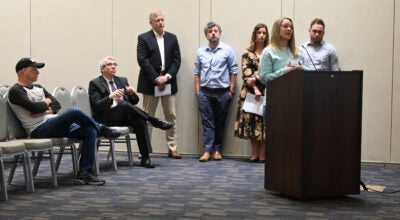Citing NC’s coal ash controversy, Brockovich lobbies EPA
Published 6:25 pm Monday, August 15, 2016
By Josh Bergeron
josh.bergeron@salisburypost.com
SALISBURY — She was at the center of a California water quality case and has a movie named after her. Now, environmental activist Erin Brockovich is weighing in on North Carolina’s coal ash controversy.
Brockovich is the co-author of a letter sent to the Environmental Protection Agency that lobbies the federal government to speed up its determination of how much hexavalent chromium is safe to drink. Hexavalent chromium can cause cancer and is a metal that’s been at the center of questions about whether well water near coal ash ponds is safe to drink. Environmental Working Group, a nonprofit advocacy group based in Washington, D.C., is also a co-author.
Brockovich became well known following a 1990s environmental case in Hinkley, California, where wastewater containing hexavalent chromium was allegedly contaminating drinking water. She was played by actress Julia Roberts in the 2000 film “Erin Brockovich.”
Her letter uses North Carolina as an example of what can happen when no federal standard exists for hexavalent chromium. It specifically cites last week’s resignation of epidemiologist Megan Davies and the state’s criticism of toxicologist Ken Rudo.
“When Davies claimed in her resignation letter that the administration is deliberately misleading the public about safe levels of hexavalent chromium, there is little that she or other concerned state officials or citizens can do under current law, as there is no federal enforceable health-protective standard to which she can point,” the letter states.
Continuing, the letter states that there’s little room for legal action if the levels of hexavalent chromium found in water wells next to coal ash ponds pose unacceptable risks to human health.
Currently, the federal health standard allows up to 100 parts per billion of total chromium — which can include hexavalent chromium and trivalent chromium. Hexavalent chromium can cause cancer, but trivalent chromium is not considered toxic.
A 0.07-parts-per-billion level of hexavalent chromium was used in 2015 “do not drink” letters to declare water wells unsafe near North Carolina’s coal ash ponds. Rudo reportedly calculated the 0.07-parts-per-billion level to represent a one-in-a-million cancer risk. Now, wells near coal ash ponds are considered safe if the level of hexavalent chromium measures 10 parts per billion or less.
“It is clear that the delay is sowing confusion among state and local regulators, utilities and the public about how much hexavalent chromium is safe in drinking water,” today’s letter states. “This confusion is resulting in many Americans’ exposure to unregulated levels of hexavalent chromium, which federal, state and independent scientists agree pose health hazards.”
When asked about the Brockovich letter, a spokesperson for the N.C. Department of Environmental Quality sent the Salisbury Post a copy of an April report to the North Carolina General Assembly, which states “do not drink” recommendations were lifted, in part, because other states have not issued similar orders for identical levels of hexavalent chromium.
DEQ also provided a chart that included cities in California where levels of hexavalent chromium are higher than North Carolina’s current 10 parts per billion limit but locals are being told their water is safe to drink. In Davis, California, for example, water supply wells ranged from 14 to 37 parts per billion for hexavalent chromium. In saying water was OK to drink, the city cited the federal government’s limit of 100 parts per billion.
In a statement provided to the Salisbury Post, the EPA said it is in the early stages in the development of a health assessment and noted that the current federal standard allows for the 100 parts per billion amount to consist entirely of the cancer-causing hexavalent chromium.
“This (standard) is badly outdated and numerous studies and reviews, including those by the National Toxicology Program and the California Office of Health Hazard Assessment, indicate that this level is far too high to protect human health,” the letter from Brockovich counters.
The EPA’s statement did not include an estimated completion date for a hexavalent chromium standard.
At various points, state officials and Duke Energy have said hexavalent chromium and vanadium occur at natural levels. David Andrews, a senior scientist at the Environmental Working Group, agrees with that assessment. However, Andrews said the highest levels of the cancer-causing metal are “very likely” from industrial pollution.
Judging from various research on the topic, Andrews said the level of hexavalent chromium allowed in drinking water should be much lower than what the federal government currently allows. Science “has changed drastically” since the level was first set.
“We’re really just trying to kick the EPA into gear and move this process along,” Andrews said about the purpose of the letter signed by Brockovich and the Environmental Working Group.
Contact reporter Josh Bergeron at 704-797-4246.




